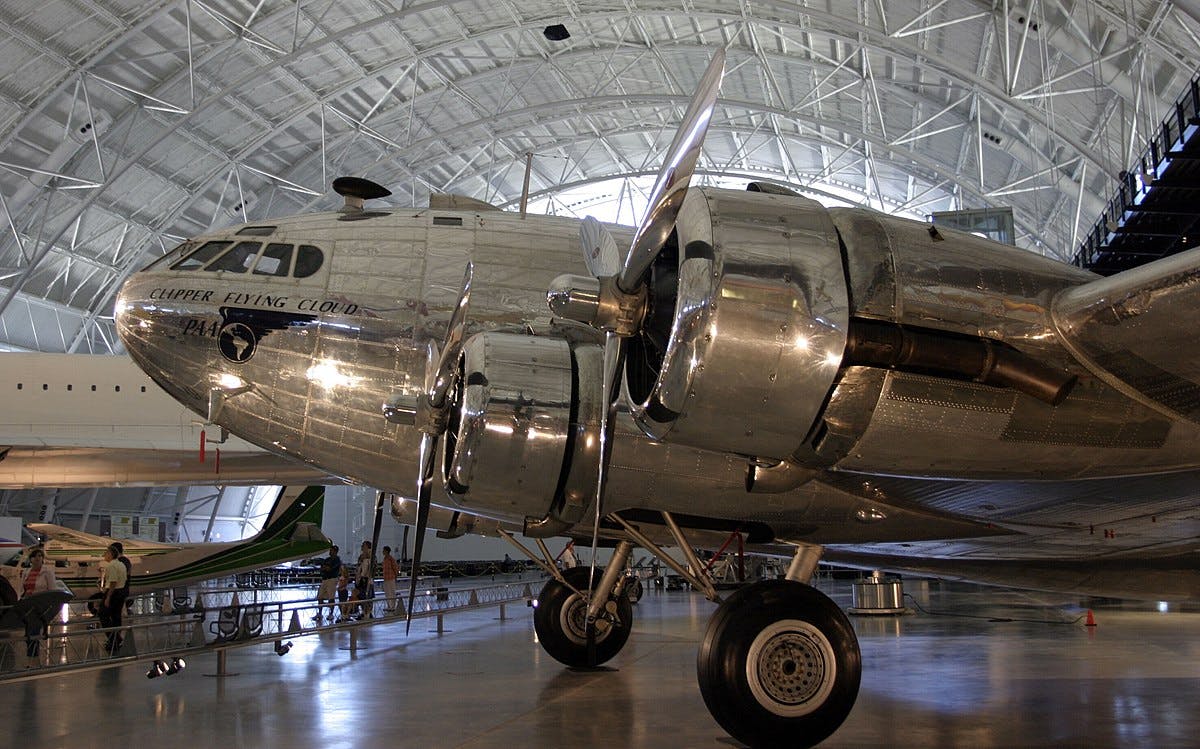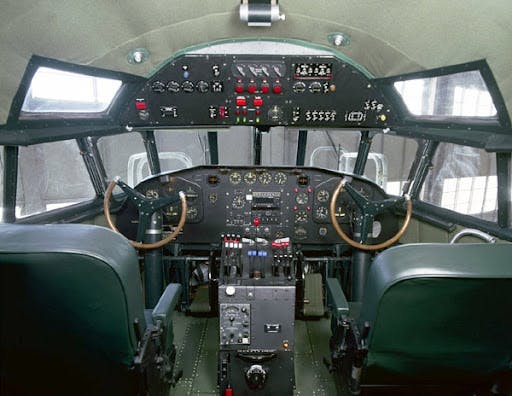Airborne ECS pioneer: Boeing 307, the first pressurized cabin airliner

Blog
Commercial air travel has changed significantly over the past hundred or so years. In some ways, it has greatly improved, particularly in the speed and efficiency of our journeys. For example, early air journeys across the USA could take over a day (25+ hours), involving up to 15 stops, several changes of planes, and might cost the adjusted-dollar equivalent of $6,500 per ticket. In other ways, such as passenger amenities, things have become much more mediocre. As we sit crammed in coach, rationing out our tiny packet of salted peanuts, we would likely not be cheered to learn of the 1938 American Airlines DC-3 flight experience, where passengers were offered cocktails, sirloin steak, Long Island duckling, pancakes with blueberry syrup, and julienne-of-ham omelets, all served on china and silver. Transcontinental sleeper flights featured individual, curtained berths with feather mattresses covered with goose-down comforters. Harrumph.
However, it could be successfully argued that the most important development in airline passenger comfort overall is the pressurized, climate-controlled cabin that today permits us to zoom along at over 500 mph (800 kph) at 35,000-42,000 feet (10,660-12,800 m) of altitude, comfortably ensconced in our knock-off Lululemon leggings, watching Tiger King reruns on our personal entertainment devices. Pressurization of the passenger compartment helps you, you know… not die, since the oxygen levels at 40,000 feet are inadequate to fill your lungs and keep your heart and brain working. And even if there were adequate oxygen up there, you’d quickly freeze to death without a really good pair of airline travel socks, as the ambient temps range from −40 to −70 °F (−40 to −57 °C). We take all of this for granted, since Air Cycle Machines (ACM) have become so reliable and commonplace that we don’t even have to consider flying in a commercial airliner without one.
But this wasn’t always the case. In the 1930s, the above-mentioned DC-3 and its contemporaries had non-pressurized cabins. This limited their maximum cruising altitude to around 11,000 feet, which was often barely enough to get them over mountain ranges, and was certainly not high enough to avoid serious turbulence and weather systems, which today we can simply scoff at from high above.

Development history of the Boeing 307
Researchers in the 1930s realized that pilots who used oxygen masks and electrically heated flight suits could fly high enough that weather issues were significantly reduced, and aircraft and airline companies began searching for technology that would allow pressurizing the entire passenger compartment. By the mid-to-late ‘30s, Boeing, Curtiss, and Douglas all had developed designs for pressurized passenger aircraft. Due to cost and performance projections, Boeing’s 307 Stratoliner proposal, based on the B-17 bomber and penned by the company’s well-known flying-boat designer, Wellwood Beall, became the frontrunner and several airlines placed advanced orders, including Pan American Airways (PAA), Transcontinental and Western Air (TWA), and even Howard Hughes.
The prototype S-307 took wing for the first time on December 31, 1938, and initial testing seemed good. However, during later flight testing (with 10 people aboard), it crashed on March 18, 1939, near Alder, Washington. All ten aboard were killed, including a representative from TWA, KLM’s technical director, a Dutch Air Ministry representative, and Boeing’s test pilot, chief aerodynamicist, and chief engineer. Horribly tragic. However, after an investigation by the US Civil Aeronautics Authority, the precursor to today’s Federal Aviation Administration, and Boeing concluded that the vertical stabilizing surfaces were inadequate, Boeing added a lengthy dorsal fin as well as a larger stabilizer. These improvements solved the instability issue during side slips, and were incorporated into later models of the B-17 Flying Fortress. Who knows how many lives these modifications saved among B-17 crew.
The improved Boeing 307 Stratoliner began flying Miami-to-Latin-America routes on July 4, 1940, for Pan American. The 307 offered significantly more passenger room and comfort than even the then-luxuriously spacious Douglas DC-3. Its fuselage was more than 3 feet (0.91 m) wider, and of course was pressurized (Boeing called it “supercharged” in its marketing of the day), heated, and air-conditioned, giving its 33 passengers the comfortable space to enjoy the views from up to 26,000 feet (7,924 m). Typical cruising altitude was 20,000 feet (6,096 meters), with the onboard systems maintaining an equivalent cabin pressure of 8,000 feet of elevation (2,438 meters).There were separate men’s and ladies’ lavatories, a galley, and available sleeping berths for overnight routes. In fact the 11.5-foot (3.5 m) wide passenger cabin of the 307 was more spacious than the groundbreaking Boeing 707 jetliner that would come later, measuring in at 11 feet (3.35 m). As noted, the first interior 307 layouts were for 33 seated passengers, but later modifications increased this to 38, and eventually up to 60.
In addition to its fully pressurized and climate-controlled cabin and its geared, 2-speed superchargers permitting smoother, more efficient high-altitude flight, the Boeing 307 also pioneered hydraulically assisted control surfaces (elevators and rudder), and at the time, the 307 was the fastest scheduled long range airliner in service, with a cruising speed of up to 220 mph (354 kph). It was also the first four-engine non-seaplane airliner in US scheduled long-range service.
Despite only 10 Boeing 307s ever being built, they were well-liked and performed admirably both during WWII and afterward. As Anthony E. Pomata of Historylink reports, “During World War II, TWA’s 307’s were taken into AAF service as the camouflaged C-75. PAA aircraft were retained by the airline, with their crews and colors flying under charter for the AAF Air Transport Command. All eight aircraft survived their wartime service. Postwar Stratoliner airline service began in late 1945 when TWA resumed coast-to-coast flights with its upgraded SA-307B-1 aircraft, and PAA flew the New York City to Bermuda route. PAA Stratoliner service ended in 1948, when its three aircraft were sold. TWA used its five SA-307B-1’s until 1951, after which they were sold off. Three aircraft were in service in Indochina during the 1970s, [and] one aircraft was reported still flying in Laos as late as 1986.”

How much did a Boeing 307 Stratoliner cost?
The 307 was not cheap, with a delivered price of around $250,000 per airplane in 1940 dollars. Adjusted for inflation, that $250,000 has the same buying power as around $5.5 million today. Other sources claim an ordered price of $315,000 in 1937, equalling approximately $6.7 million today. Still, relative to today’s cost of a new Airbus A320 at around $101 million or $25 million for a used one, the 307 starts to look like a real bargain.
It’s not often that the first attempt at a groundbreaking technology succeeds so profoundly that it remains in service for nearly 50 years, but the Boeing 307’s pressurized cabin absolutely transformed the way people move around the world, and influenced not only military aircraft but every airliner that followed it.
–By Jeff Davis, Intergalactic Scribe
Sources:
https://www.historylink.org/file/3598
https://en.aeroflap.com.br/boeing-307-stratoliner-the-first-pressurized-commercial-airliner/
https://en.wikipedia.org/wiki/Boeing_307_Stratoliner